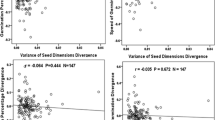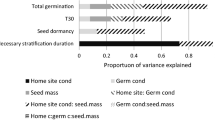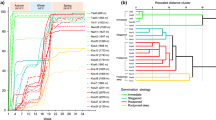Abstract
We have examined the seed germination strategy of 86 subalpine woody species from the eastern part of the Tibetan Plateau and assessed correlations between seed germination and phylogeny, life-history attributes, habitat, and altitude using stepwise analyses of variance (ANOVAs) and phylogenetically independent contrasts (PICs). A series of ANOVAs revealed that the total amount of variance in the arcsine-transformed value of germination percentage among species could be accounted for by phylogeny (19.2%) and dispersal mode (14.3%) in seeds incubated in the light and by phylogeny (29.3%) and dispersal mode (11.0%) in those incubated in the dark. In addition, the total amount of variance in T50 (days to half of the final germination) can be accounted for by phylogeny (22.7%) and dispersal mode (17%) in seeds incubated in the light and by phylogeny (32.1%) and dispersal mode (9.9%) in those incubated in the dark. PICs indicated a significant correlation between germination percentage and dispersal mode and a positive correlation between T50 and seed mass, showing that wind-dispersed seeds had higher germination percentages than both unassisted and vertebrate-dispersed seeds and that small seeds germinated faster than large ones. We suggest that phylogeny and dispersal mode may constrain variation in seed germination across species and that the speed of germination and seed mass may co-vary to adapt to a variable environment. Therefore, from an evolutionary perspective, seed germination might be the result of both selective pressures over long-term ecological time and phylogenetic constraints over the long-standing evolutionary history of the phylogenetic group.



Similar content being viewed by others
References
Angiosperm Phylogeny Group (2009) An update of the Angiosperm Phylogeny Group classification for the orders and families of flowering plants: APG III. Bot J Linnean Soc 161:105–121
Augspurger CK (1983) Seed dispersal of the tropical tree, Platypodium elegans, and the escape of its seedlings from fungal pathogens. J Ecol 71:759–771
Baskin CC, Baskin JM (1998) Seeds: ecology, biogeography, and evolution of dormancy and germination. Academic Press, San Diego
Baskin JM, Baskin CC (2004) A classification system for seed dormancy. Seed Sci Res 14:1–16
Bell G (1989) A comparative method. Am Nat 133:553–571
Bu HY, Chen XL, Xu XL, Liu K, Wen SJ, Du GZ (2007) Community-wide germination strategies in an alpine meadow on the eastern Qinghai-Tibet plateau: phylogenetic and life-history correlates. Plant Ecol 191:127–149
Chambers JC, MacMahon JA (1994) A day in the life of a seed: movements and fates of seeds and their implications for natural and managed systems. Annu Rev Ecol Syst 25:263–292
Chen ZH, Peng JF, Zhang DM, Zhao JG (2002) Seed germination and storage of woody species in the lower subtropical forest. Acta Bot Sin 44:1469–1476
Cheplick GP (1993) Sibling Competition is a consequence of restricted dispersal in an annual cleistogamous grass. Ecology 74:2161–2164
Dolan RW (1984) The effect of seed mass and maternal source on individual mass in a population of Ludwigia leptocarpa (Onagraceae). Am J Bot 71:1302–1307
Donohue K, Dorn L, Griffith C, Kim E, Aguilera A (2005) The evolutionary ecology of seed germination of Arabidopsis thaliana: variable natural selection on germination timing. Evolution 59:758–770
Felsenstein J (1985) Phylogenies and the comparative method. Am Nat 125:1–15
Fenner M, Thompson K (2005) The ecology of seeds. Cambridge University Press, Cambridge
Figueroa JA (2003) Seed germination in temperate rain forest species of southern Chile: chilling and gap-dependency germination. Plant Ecol 166:227–240
Figueroa JA, Armesto JJ (2001) Community-wide germination strategies in a temperate rainforest of Southern Chile: ecological and evolutionary correlates. Aust J Bot 49:411–425
Fragoso JMV, Silvius KM, Correa JA (2003) Long-distance seed dispersal by tapirs increase seed survival and aggregates tropical trees. Ecology 84:1998–2006
Garland TJr (1992) Rate tests for phenotypic evolution using phylogenetically independent constrains. Am Nat 140:509–519
Garland TJr, Harvey PH, Ives AR (1992) Procedures for the analysis of comparative data using phylogenetically independent contrast. Syst Biol 41:18–32
Garwood NC (1983) Seed germination in a seasonal tropical forest in panama: a community study. Ecol Monogr 53:159–181
Greenberg CH, Smith LM, Levey DJ (2001) Fruit fate, seed germination and growth of an invasive vine: an experimental test of ‘sit and wait’ strategy. Biol Invasions 3:363–372
Gross KL, Smith AD (1991) Seed mass and emergence time effects on performance of Panicum dichotomiflorum Michx. across environments. Oecologia 87:270–278
Guo QF, Brown JH, Valone TJ, Kachman SD (2000) Constraints of seed mass on plans distribution and abundance. Ecology 81:2149–2155
Gutterman Y (2000) Environmental factors and survival strategies of annual plant species in the Negev desert, Israel. Plant Species Biol 15:113–125
Hastie TJ, Botha JL, Schnitzler CM (1989) Regression with an ordered categorical response. Stat Med 8:785–794
Hendry GA, Grime JP (1993) Methods in comparative plant ecology. Chapman and Hall, London
Hidayati SN, Baskin JM, Baskin CC (2001) Dormancy-breaking and germination requirements for seeds of Symphoricarpos prbiculaus (Caprifoliaceae). Am J Bot 88:1444–1451
Jakobsson A, Eriksson O (2000) A comparative study of seed number, seed size, seedling size and recruitment in grassland plants. Oikos 88:494–502
Janzen DH (1970) Herbivores and the number of tree species in tropical forests. Am Nat 104:501–528
Jurado E, Westoby M (1992) Seedling growth in relation to seed size among species of arid Australia. J Ecol 80:407–416
Kochmer JP, Handel SN (1986) Constraints and competition in the evolution of flowering phenology. Ecol Monogr 56:303–325
Kyereh B, Swaine MD, Thompson J (1999) Effect of light on the germination of forest trees in Ghana. J Ecol 87:772–783
Leishman MR (2001) Does the seed mass/number trade-off model determine plant community structure? An assessment of model mechanisms and their generality. Oikos 93:294–302
Leishman MR, Westoby M, Jurado E (1995) Correlates of seed mass variation: a comparison among five temperate floras. J Ecol 83:517–529
Lian YS, Lu SG, Xue SK, Chen XL (2001) Biology and chemistry of Hippophae species. Science and Technology Press, Gansu (in Chinese)
Mazer SJ (1989) Ecological, taxonomic, and life history correlates of seed mass among Indiana dune angiosperms. Ecol Monogr 59:153–175
Mckitrick MC (1993) Phylogenetic constraint in evolutionary theory: has it ant explanatory power? Annu Rev Ecol Syst 24:307–330
Meyer SE, Kitchen SG (1994) Habitat-correlated variation in seed germination response to chilling in Penstemon section Glabri (Scrophulariaceae). Am Midl Nat 132:349–365
Milberg P, Andersson L, Thompson K (2000) Large-seeded species are less dependent on light for germination than small-seeded ones. Seed Sci Res 10:99–104
Miles DB, Dunham AE (1993) Historical perspectives in ecology and evolutionary biology: the use of phylogenetic comparative analyses. Annu Rev Ecol Syst 24:587–619
Miller T (1987) Effects of emergence time on survival and growth in an early old-field plant community. Oecologia 72:272–278
Norden N, Daw MI, Antoine C, Gonzalez MA, Garwood NC, Chave J (2009) The relationship between seed mass and mean time to germination for 1037 tree species across five tropical forests. Funct Ecol 23: 203–210
Paz H, Susan JM, Martinez-Ramos M (1999) Seed mass, seedling emergence, and environmental factors in seven rain forest Psychotria (Rubiaceae). Ecology 80:1594–1606
Qing ZS, Cai XS, Huang JY (1989) Seed characteristics and natural regeneration of Arrow Bamboo (Bashania fangiana) (in Chinese). J Bamboo Res 8:1–12
Quader S, Isvaran K, Hale RE, Miner BG, Seavy NE (2004) Nonlinear relationships and phylogenetically independent contrasts. J Evol Biol 17:709–715
Rascio N, Mariani P, Vecchia FD, Rocca N (1998) Effects of seed chilling or GA3 supply on dormancy breaking and plantlet growth in Cercis siliquastrum L. Plant Growth Regul 25:53–61
Rosner L, Harrington JT, Dreesen DR, Murray L (2001) Influence of provenance on Ribes cereum and Symphoricarpos oreophilus seed germination in New Mexico seed sources. In: 21st Proc American Society for Surface Mining and Reclamation, vol 1, pp 31–38
Sautu A, Baskin JM, Baskin CC, Condit R (2006) Studies on the seed biology of 100 native species of trees in a seasonal moist tropical forest, Panama, Central America. Forest Ecol Manag 234:245–263
Shen HL, Yang L, Zhang JY, Feng DD, Fan SH (2006) Influencing factors to seed dormancy and germination characteristics of Sorbus pohuashanensis (in Chinese). Sci Silvae Sinicae 42:133–138
Shipley B, Parent M (1991) Germination responses of 64 wetland species in relation to seed mass, minimum time to reproduction and seedling relative growth rate. Funct Ecol 5:111–118
Simons AM, Johnston M (2006) Environmental and genetic sources of diversification in the timing of seed germination: implications for evolution of bet hedging. Evolution 60:2280–2292
Stanton ML (1984) Seed variation in wild radish: effect of seed mass on components of seedling and adult fitness. Ecology 65:1105–1112
Vanhatalo V, Leinonen K, Rita H, Nygren M (1996) Effect of prechilling on the dormancy of Betula pendula seeds. Can J For Res 26:1203–1208
Venable DL (1985) The evolutionary ecology of seed heteromorphism. Am Nat 126:577–595
Wang JH, Baskin CC, Cui XL, Du GZ (2009) Effect of phylogeny, life history and habitat correlates on seed germination of 69 arid and semi arid zone species from northwest China. Evol Ecol 23:827–846
Webb CO, Ackerly DD, Kembel SW (2008) Phylocom: software for the analysis of phylogenetic community structure and trait evolution. Bioinformatics 24:2098–2100
Willson MF, Traveset A (2000) The ecology of seed dispersal. In: Fenner M (ed) Seed—the ecology of regeneration in plant community, 2nd edn. CABI Publ, New York, pp 26–103
Winn AA (1988) Ecological and evolutionary consequences of seed mass in Prunella vulgaris. Ecology 69:1537–1544
Wulff RD (1986) Seed mass variation in Desmodium paniculatum. III effect on reproductive yield and competitive ability. J Ecol 74:115–121
Zhang ST, Du GZ, Chen JK (2004) Seed size in relation to phylogeny, growth form and longevity in a subalpine meadow on the east of the Tibetan Plateau. Folia Geobot 39:129–142
Acknowledgments
We thank Xuelin Chen and Wei Qi for identifying the species. This study was supported by the Nature Science Foundation of China (31040009), Nature Science Foundation of Gansu Province (1010RJZG204), Key Laboratory of Hexi Corridor Resources Utilization of Gansu Universities (XZ1013), and by Postgraduate Supervisor Projects of Department of Education of Gansu Province (1009-08).
Author information
Authors and Affiliations
Corresponding authors
Appendix
Appendix
See Table 6.
About this article
Cite this article
Wang, J., Chen, W., Baskin, C.C. et al. Variation in seed germination of 86 subalpine forest species from the eastern Tibetan Plateau: phylogeny and life-history correlates. Ecol Res 27, 453–465 (2012). https://doi.org/10.1007/s11284-011-0916-2
Received:
Accepted:
Published:
Issue Date:
DOI: https://doi.org/10.1007/s11284-011-0916-2




